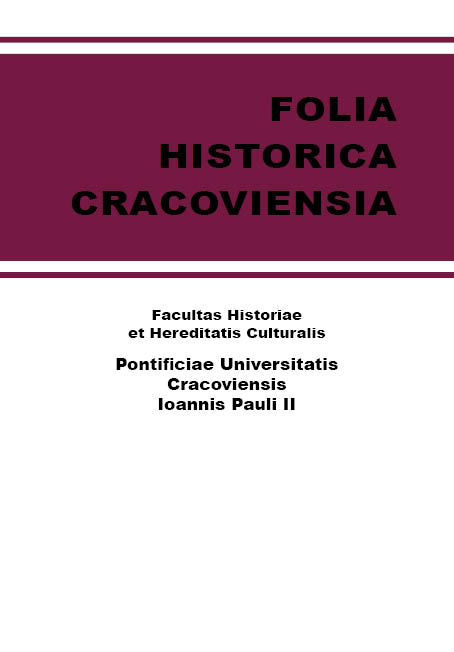Sacrum w układach przestrzennych lokacyjnych miast Małopolski w XIII–XV wieku
The Sacred in the Spatial Arrangements of Chartered Cities in Małopolska in 13th–15th Centuries
Author(s): Bogusław KrasnowolskiSubject(s): History, Social history, Middle Ages, 13th to 14th Centuries, 15th Century
Published by: Wydawnictwo Naukowe Uniwersytetu Papieskiego Jana Pawła II w Krakowie
Keywords: Churches of the Canons Regular of the Holy Sepulchre, Miechów; patrocinia; relics; 12th to 16th c.
Summary/Abstract: The author presents the findings of his own studies on the presence of relics and dedications in the churches of Canons Regular of the Holy Sepulchre in medieval Polonia Minor (covering the former Krakow and Sandomierz voivideships). The article reveals important accounts in Samuel Nakielski’s chronicle. The first account relates bringing the soil from Jerusalem by Jaksa and is known in literature. The second account concerns the possession of the relics of the Holy Cross by the monastery of Canons Regular of the Holy Sepulchre, hitherto unknown in literature. The author formulates a thesis on the existence of important relics of the Passion in the Miechów monastery. Key source accounts on dedications were analysed. It was indicated that the primary dedication of the Miechów church towards the end of the 18th century was a combined invocation of the Holy Sepulchre, the Holy Spirit and Blessed Virgin Mary. The author also extensively analyses the dedication of the church in Żarnowiec, with dedications to both feasts related to the Holy Cross, to the Holy Spirit, the Holy Sepulchre and Blessed Virgin Mary. The dedications of 10 other churches administered by Canons Regular of the Holy Sepulchre are also discussed. In addition, the author presents a substantial collection of data on the dedications of surviving altars and chapels in relation to the Miechów church and St Jadwiga’s Church in Stradom. In conjunction with the information on numerous relics of saints, the findings should become a departure point for further studies. /Przestrzeń sakralną można rozpatrywać pod kątem funkcji (zespoły parafialne, klasztorne i „inne”) oraz genezy (zespoły przedlokacyjne, z doby lokacji i polokacyjne). Wielkie zróżnicowanie tej przestrzeni prezentuje Kraków doby lokacji z 1257 roku wraz z włączonym doń podgrodziem – Okołem i przedmieściami; odrębne miejsce zajmuje sacrum związane z najstarszą krakowską gminą żydowską. Znaczącą rolę odgrywało sacrum w układzie urbanistycznym większego krakowskiego satelity – Kazimierza, skromniej przedstawiało się na Kleparzu. Znaczne zróżnicowanie obserwujemy w przedlokacyjnym, lokacyjnym i polokacyjnym Sandomierzu. Pewną specyfiką wyróżniały się miasta górnicze: Bochnia, Wieliczka i Olkusz. Odrębne zagadnienie wiąże się z „peregrynacją” Sącza: przedlokacyjnym Sączem wiązanym z późniejszym Pogrodziem, Sączem św. Kingi (Starym) i Nowym Sączem. W większości niewielkich miast małopolskich sacrum ograniczone było do zespołu kościoła parafialnego (fundowanego wraz z lokacją, niekiedy ją poprzedzającego, rzadziej pojawiającego się po lokacji), niekiedy też do mendykanckiego zespołu klasztornego i szpitala (z kaplicą).
Journal: Folia Historica Cracoviensia
- Issue Year: 21/2015
- Issue No: 1
- Page Range: 7-44
- Page Count: 38
- Language: English

